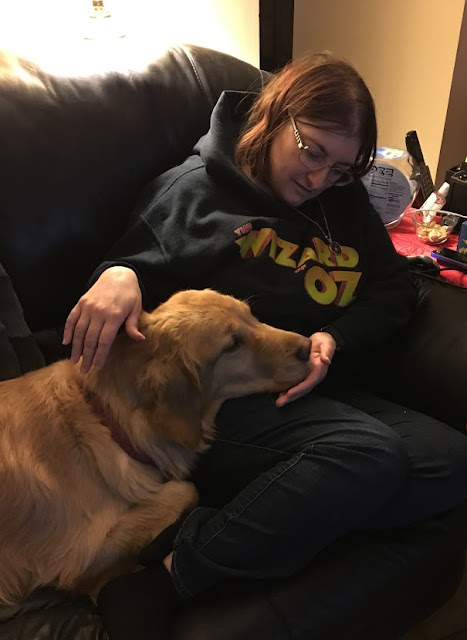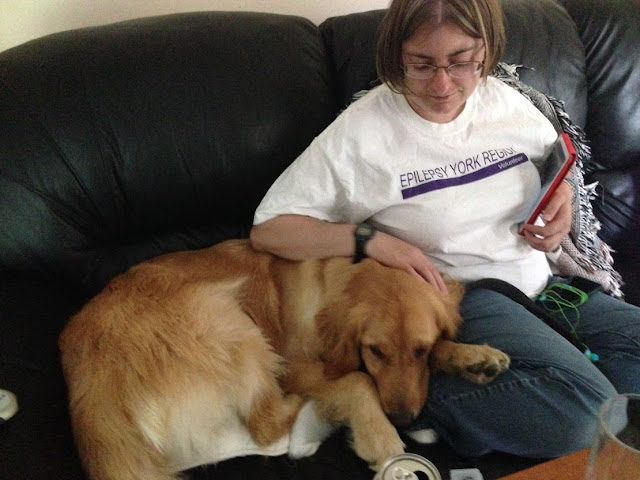We are SO grateful to have received enough donations (both cash and through Go Fund Me) to cover another month of training for Cable!! We had one incredibly large donation last week, which really helps our cause. We still have around 20 months to fund-raise for. If you can share our posts to spread the word, we would really appreciate it!
Thank you to everyone for your continuing support.
As March is Epilepsy Awareness Month in Canada I thought I would share some information about Amanda's seizures.
There are many
different types of seizures and they all present quite differently.
Amanda’s seizure
types have changed throughout the years.
These are her current seizure types, and this is how a service-dog
assists her.
Tonic clonic/generalized
onset—This presents as the body jerking. In Amanda’s case it usually begins with one
arm convulsing, to eye and mouth twitching and eventually spreads to involve
the whole body. In almost all cases she loses consciousness with these seizures,
and requires emergency (“rescue”) medication to stop them.
Amanda’s dogs are trained to recognize the movements of this type of
seizure as a signal to press the emergency button, summoning help. As mentioned in a previous post, Amanda has a
history of Status Epilepticus, a state in which the seizure will not stop
unless rescue medication is administered, generally by means of IV. Immediate action is necessary. Since Amanda lives on her own, activation of
the emergency button is a life-saving action her service dog can provide.
Cable is learning this task. Recheck the January 14th post to watch the video of Cable learning the first steps to press the button!
Simple partial / focal
aware—During these seizures Amanda becomes temporarily blind but remains
aware. These seizures may be brief but
can appear in clusters. They are her
most common type of seizure, and occur daily. Amanda’s dogs respond to the cue,
“Kisses,” to lick her hand. This helps
to shorten the seizure. If the seizure
is more than a few seconds and Amanda is walking at the time, she can cue her
dog to find her a “seat” so that she can sit while she recovers from the
seizure and regains her vision. If she
loses her sight while crossing the street her dog is trained to pull her
quickly to the other side out of traffic.
The dog will also stop her from beginning to cross the road if Amanda’s
seizure activity prevents her from giving the dog the command to enter the
street.
 |
| Kira learning to give "kisses" when needed. |
To the average onlooker, these focal aware seizures may not be apparent, yet they could potentially put her in danger. Her seizure-response dogs keep her safe.
Simple partial/motor
onset aware Amanda often experiences this type of seizure
upon waking. Her hand and/or arm begins
to twitch or shake. She is conscious and
aware during this type of seizure. For
the most part, these seizures subside on their own, but they are
unsettling. Amanda’s service dog will climb
into bed with her to provide some comfort through deep pressure therapy, or to
calm her anxiety by just snuggling with Amanda.
Complex partial/focal impaired awareness—When this
type of seizure occurs, Amanda is conscious but may be confused, and not able
to understand or respond appropriately.
She may have small repetitive movements and she may wander. Her dog will remain with her, leashed around
her waist, and will be able to prevent her from walking into dangerous
situations. When she comes out of the
seizure and awareness returns, Amanda can cue the dog to take her “Home” or to
a familiar spot, as she will often be in a confused state and will not
recognize where she is. Her dog knows
the neighbourhood well, and will guide her home.
GO FUND ME: https://bit.ly/3fvYtxd
BLOG: https://cablescalling.blogspot.com/
FACEBOOK: https://www.facebook.com/Cables-Calling-Born-to-be-a-Service-Dog-101555021631826/?view_public_for=101555021631826BLOG








No comments:
Post a Comment